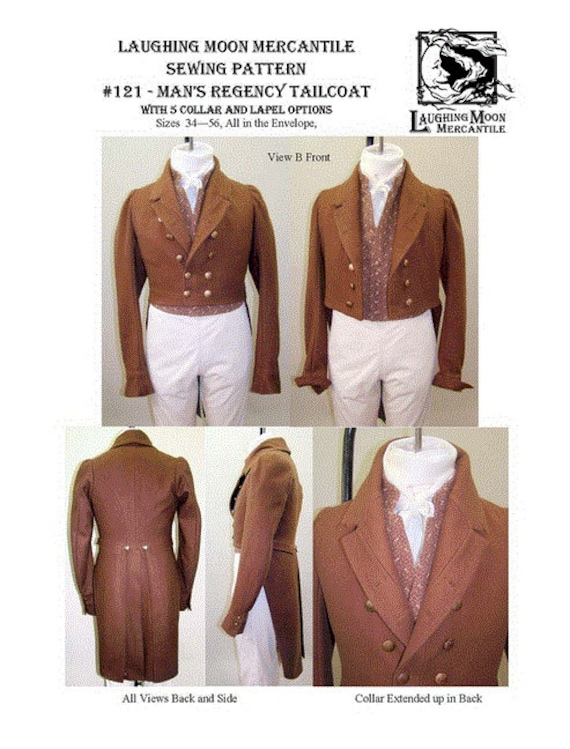LM121- 1810 – 1830 Men's Regency Tailcoat with Five Collar and Lapel Options Sewing Pattern by Laughing Moon by patternsoftime

17.95 USD
LM121- 1810 – 1830 Men's Regency Tailcoat with Five Collar and Lapel Options. Sewing Pattern – 1810 – 1830 Men's Regency Tailcoat with Five Collar and Lapel Options. Research based patterns suitable for historic interpretation, with clear instructions for intermediate sewers and detailed options for professionals. Men's Regency Tailcoat with 5 lapel and Collar Options. Sizes 34 to 56 included in the Envelope.
Men's Regency Tailcoat with Five Collar and Lapel Options. Period 1810 – 1830
This tailcoat has a waist seam and is double breasted with the bottom two buttons meant to be buttoned. When buttoned the collar and lapels bow out to make room for shirt, cravat,
and up to two vests. The collar stands approximately 3 inches tall at the back of the neck when folded over. The front of the coat is cut broad and the back narrow, forcing an erect stance
or may even throw the shoulders back. The fit is very close. The sleeves are very long, meaning to end at the wrist or longer, with the cuffs adding another 3 inches so that the sleeves with cuffs end at the knuckles of the hand. The sleeves fit very closely except at the top where they are puffed and full. The shoulders are cut very narrow. There are two separate tails that overlap at center back. The coat has an inside breast pocket and there are two tail pockets. The back has two pocket flaps that are only decorative. View A can be made with any wool. Views B, D, D, and E have a collar and lapel that must be made with wool that does not ravel or ravels very little.
View A lapel is a simple notched collar, which could be made with the upper collar of velvet if desired. View B is a small "M" notch. View C was called a "Lark's Tongue" notch and
is very pointed. View D is a wide "M" notch. View E is a long touching "M" notch. The instructions have both period and modern (theatrical) tailoring instructions. Information about fabric, interfacing, lining, fit, and supplies sources are included inside the pattern.
Fabric: Wool 12 to 24 oz. This type of fairly thick, felted wool can be called Melton, Coating, Pilot Cloth, Doeskin, Broadcloth, or Flannel. Sleeve Lining and Pocketing: Bleached Muslin or modern lining fabric. Chest Interfacing: Linen canvas or modern hair canvas interfacing.
Collar and Front Facing Interfacing: Wool Melton or Linen Canvas or modern hair canvas interfacing.
Optional inside lining: Silk Faille or modern lining. Notions: Sixteen 5/8" or 3/4" shank buttons, four 3/8" or 1/2" shank buttons. Optional for modern construction: 1/4" Fusible stay tape
Excellent for Jane Austen's Pride and Prejudice, Sense and Sensibility and other Regency era impressions. Beau Brummell wore a Regency period dress coat as daytime dress. The coat is able to close and the tails are knee length. Beau Brummell set the fashion for British society from the mid-1790s, which was characterized by immaculate personal cleanliness, immaculate linen shirts with high collars, perfectly tied cravats, and exquisitely tailored plain dark coats. Brummell abandoned his wig and cut his hair short in a Roman fashion dubbed à la Brutus, echoing the fashion for all things classical seen in women's wear of this period. He also led the move from breeches to snugly-tailored pantaloons or trousers, often light-colored for day and dark for evening, based on working-class clothing adopted by all classes in France in the wake of the Revolution. A tailcoat is a coat with the front of the skirt cut away, so as to leave only the rear section of the skirt, known as the tails. The historical reason coats were cut this way was to make it easier for the wearer to ride a horse, but over the years tailcoats of varying types have evolved into forms of formal dress for both day and evening wear. Although there are several different types of tailcoat, the term tailcoat is popularly taken to be synonymous with the type of dress coat still worn today in the evening with white tie. This dress coat, one of the two main surviving tailcoats, is a dark evening coat with a squarely cut away front. The other one is the morning coat (or cutaway in American English), which is cut away at the front in a gradual taper. (Wikipedia).
Read More (View all photos)







